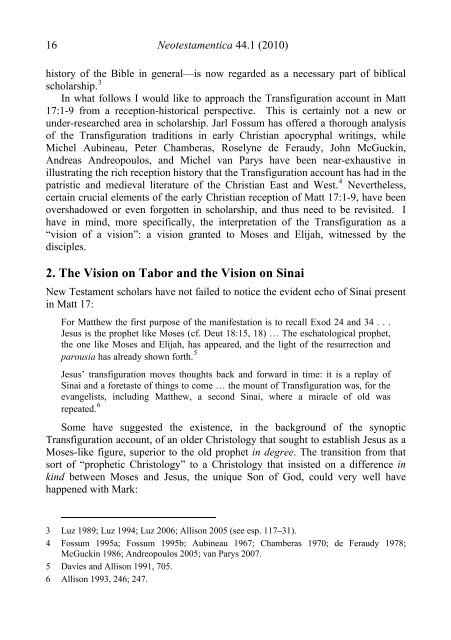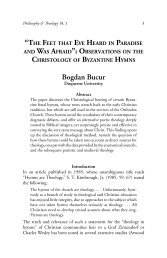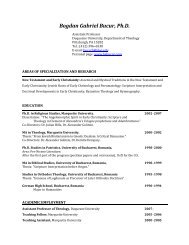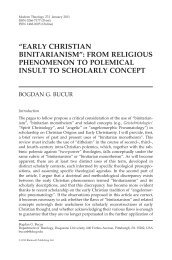Neotestamentica - bogdan g. bucur, ph.d.
Neotestamentica - bogdan g. bucur, ph.d.
Neotestamentica - bogdan g. bucur, ph.d.
Create successful ePaper yourself
Turn your PDF publications into a flip-book with our unique Google optimized e-Paper software.
16 <strong>Neotestamentica</strong> 44.1 (2010)<br />
history<br />
of the Bible in general—is now regarded as a necessary part of biblical<br />
scholarship.<br />
nd, more specifically, the interpretation of the Transfiguration as a<br />
“vision of a vision”: a vision granted to Moses and Elijah, witnessed by the<br />
3<br />
In what follows I would like to approach the Transfiguration account in Matt<br />
17:1-9 from a reception-historical perspective. This is certainly not a new or<br />
under-researched area in scholarship. Jarl Fossum has offered a thorough analysis<br />
of the Transfiguration traditions in early Christian apocry<strong>ph</strong>al writings, while<br />
Michel Aubineau, Peter Chamberas, Roselyne de Feraudy, John McGuckin,<br />
Andreas Andreopoulos, and Michel van Parys have been near-exhaustive in<br />
illustrating the rich reception history that the Transfiguration account has had in the<br />
patristic and medieval literature of the Christian East and West. 4 Nevertheless,<br />
certain crucial elements of the early Christian reception of Matt 17:1-9, have been<br />
overshadowed or even forgotten in scholarship, and thus need to be revisited. I<br />
have in mi<br />
disciples.<br />
2. The Vision on Tabor and the Vision on Sinai<br />
New Testament scholars have not failed to notice the evident echo of Sinai present<br />
in Matt<br />
17:<br />
For Matthew the first purpose of the manifestation is to recall Exod 24 and 34 . . .<br />
Jesus is the pro<strong>ph</strong>et like Moses (cf. Deut 18:15, 18) … The eschatological pro<strong>ph</strong>et,<br />
the one like Moses and Elijah, has appeared, and the light of the resurrection and<br />
parousia has already shown forth. 5<br />
Jesus’ transfiguration moves thoughts back and forward in time: it is a replay of<br />
Sinai and a foretaste<br />
of things to come … the mount of Transfiguration was, for the<br />
evangelists, including Matthew, a second Sinai, where a miracle of old was<br />
repeated. 6<br />
Some have suggested the existence, in the background of the synoptic<br />
Transfiguration account, of an older Christology that sought to establish Jesus as a<br />
Moses-like figure, superior to the old pro<strong>ph</strong>et in degree. The transition from that<br />
sort of “pro<strong>ph</strong>etic Christology”<br />
to a Christology that insisted on a difference in<br />
kin d between Moses and Jesus, the unique Son of God, could very well have<br />
happened<br />
with Mark:<br />
3 Luz 1989; Luz 1994; Luz 2006; Allison 2005 (see esp. 117–31).<br />
4 Fossum 1995a; Fossum 1995b; Aubineau 1967; Chamberas 1970; de Feraudy 1978;<br />
McGuckin 1986; Andreopoulos 2005; van Parys 2007.<br />
5 Davies and Allison 1991, 705.<br />
6 Allison 1993, 246; 247.





